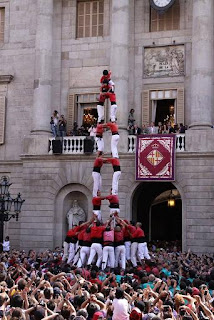25.09.10
Antiga Fàbrica Damm - Barcelona
Otro de los highlights de la Mercè son los conciertos gratuitos... no siempre del mejor nivel, aunque siempre con un par de nombres importantes. Belle & Sebastian era uno de los que no me quería perder, y bien que hice.
La esquina estaba a tope para todos lados, con pantallas gigantes en las calles perpendiculares. Aunque nosotros nos pudimos ubicar más o menos cerca, en la esquina.
Bien por la puntualidad, 22:30 apareció la banda, lo que no suele ocurrir siempre. Suenan al principio un tema del último disco, Belle and Sebastian Write About Love [2010], que llegué a escuchar poco antes del concierto. Bueno, aunque sin llegar a la altura de los mejores. Abren entonces con I didn't see it coming.

"Bona nit a tothom" - con que poco le alcanzó a Stuart Murdoch para terminar de comprar mi simpatía
Pasamos entonces al que posiblemente sea su mejor álbum de la década que termina, Dear Catastrophe Waitress [2003]. Suena primero la guitarra pegadiza de I'm a Cuckoo y sigue la flauta en el inicio de Step into My Office
"This is for our older fans... unfortunately there are many"
Se refiere a uno de los temas de su segundo (y primer gran) álbum, If You're Feeling Sinister [1996]. Suena Like Dylan in the movies.

Luego de otro tema del último álbum, llega hora de bajar un cambio con la melódica Piazza, New York Catcher antes de la remontada de Sukie in the Graveyard y Another Sunny Day, de The Life Pursuit [2006].
El siguiente momento íntimo lo trajo Lord Anthony, antes de uno de los highlights de la noche, el tema que da el nombre al álbum The Boy with the Arab Strap [1998], donde invitaron a algunos del público al escenario, einfach para bailar y divertirse.
El tramo final trajo una seguidilla de buenos temas: If You Find Yourself Caught in Love, Judy and the Dream of Horses. Y sonaron finalmente las palmas en el primer cierre, con Sleep the Clock around.

Después de la salida, Murdoch presentó al resto de la banda, antes de cerrar con el único bis de la noche, Me and the Major.
El show acusó el mal sonido, que no acompañó en ese sentido; aunque es una limitación algo lógica de tocar en una esquina al aire libre. También el humo, de momentos resultó excesivo. Pero la música estuvo muy buena, y además era gratarola, asi que no nos vamos a poner exquisitos. Una buena noche.
SETLIST
I Didn't See It Coming
I'm a Cuckoo Step into My Office
Like Dylan In The Movies
I'm not Living in the Real World
Piazza, New York Catcher
Sukie in the Graveyard
Get Me Away From Here, I'm Dying
Another Sunny Day
Write About Love
Lord Anthony
There's too Much Love
The Boy with the Arab Strap
If You Find Yourself Caught in Love
Judy and the Dream of Horses
Sleep the Clock Around
***
Me and the Major


























































